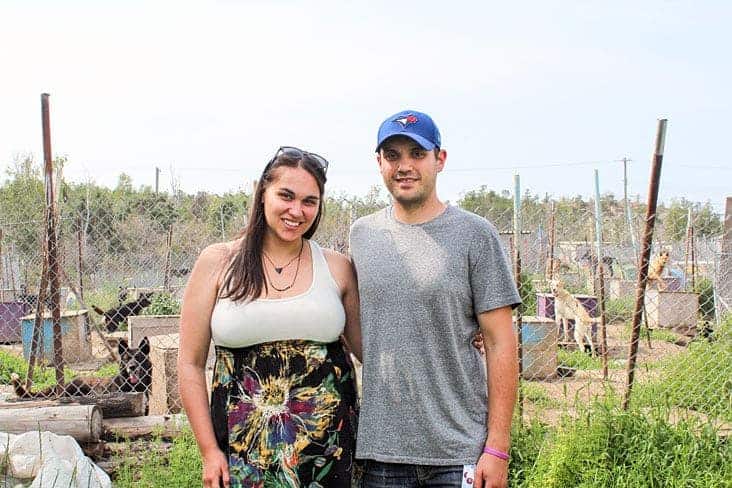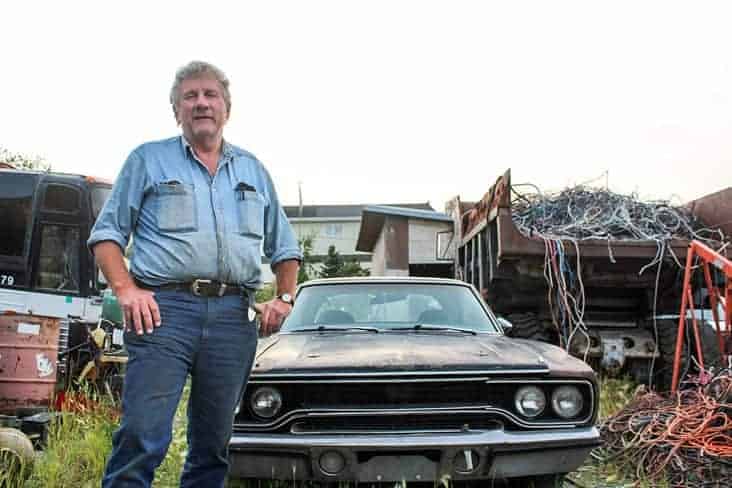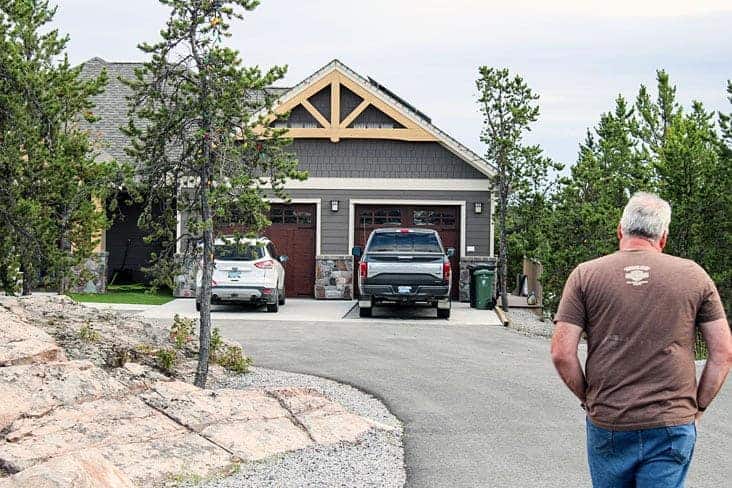Flanked by a labyrinth of kennels and surrounded by a chorus of canine calls, Jordee Reid wades into a lush, narrow corridor, its tall grass kneeling to the hot July sun.
The path is one she knows well – it’s just around the corner from the doghouses she would crawl into as a young girl on her family’s Curry Drive lot – “dog mush central,” as she calls it.

“The sense of place here is very strong,” says Reid.
She points to the west. Where her gaze ends, and where the grassy passage fades out of sight, Kam Lake begins.
Its waters are still and calm. But inland, among a potpourri of sun-kissed and sunken snowmobiles, overgrown alleys, rusting vehicles and towering machinery, Kam Lake is anything but stagnant.
Times are changing.
Once worlds apart from the City of Yellowknife, the former fringe outlier – home to a mishmash of dog mushers, industrial and commercial operators and business-owner residences – is now in the crosshairs of creeping residential sprawl.
As the city revamps its zoning bylaws – banning new kennels and adopting mixed zoning – and the area’s valuable land becomes increasingly attractive to high-income home buyers putting millions of dollars into lakefront houses, Kam Lake, once a full-fledged industrial park, is caught at a crossroads between its roots and the encroaching development it faces.
It’s a convergence that has led to conflicts.
Reid, who was recently elected president of the Yellowknife Dog Trotters Association, isn’t just pointing at Kam Lake, the backdrop to her home, she’s revealing a series of extensive dog sledding trails, cultivated and maintained by generations of sledders season after season. But, as she describes the network of trails, Reid’s words are measured with trepidation. In the midst of ongoing negotiations with the city, the Dog Trotters’ kennels and dogs could be moved out of Kam Lake, away from the trails they’ve raced along and helped preserve.
“This is one of the big reasons we want to stay here,” Reid says, her eyes fixed on the horizon. “When something’s so interwoven into your culture and your identity, that’s just what you do.”
Dodging explusion
Unlike other kennel owners in Kam Lake, who have been grandfathered in zoning amendments, the association doesn’t own the land its lot sits on – the city does. The collective, which pays an annual lease to the city, faced expulsion from the lakefront site in November. The idea was that the dogs would be relocated to the newly-formed Engle Business District – an area that restricts caretaker quarters.

Since the Kam Lake industrial park took shape, small caretaker suites, usually attached or built close to businesses, have been a mainstay, and a necessity. Many business owners, and especially kennel operators, required caretaker quarters to protect their livelihoods from thieves and animal predators.
After Reid and fellow members of the Trotters made impassioned pleas at city hall – arguing that the close proximity between caretakers and dogs they oversee was too integral to be broken – the city granted a two-year lease.
As negotiations continue, Reid and the Dog Trotters are asking to purchase their current leased lot, and want the city to explore new lands – within city limits with access to municipal services – where dogs and their owners can coexist freely.
“It’s a huge part of your identity when you’re raised as a dog musher,” says Reid, petting one of the dozen dogs that swarm her as she enters a pen. Adding that a loss of dog mushing tradition and culture in Kam Lake would take away a “big piece” of who she is, Reid doesn’t want to be relocated by city again.
In 1978, as the face of Old Town changed amid shifting city plans, Yellowknife’s dog mushers, who originally settled along Niven Lake, were “politely motivated” to relocate to Kam Lake, as historian Ryan Silke puts it.
They moved into a neighborhood that had, seven years earlier, advertised its first 10 for-sale lots in the then-new Kam Lake Industrial Park - created by the realization of city planners that the town needed an industrial zone removed from Yellowknife’s budding boom. After signing the lease with the city, the trotters were told they’d never have to move again.
Kam Lake, named after an ambiguous 1935 gold claim near a body of water, saw little development until the 1970s – apart from the construction of Kam Lake Road and the erection of a radio tower in the 1940s – but the area was no stranger to industrial and agricultural use.
In the late 1950s, Bevan's Dairy Farm operated where the Multiplex stands today, with cows being led to the waters of Kam Lake to drink. Due to arsenic contaminated water, cold weather – or both – the cows died, and so did the agricultural endeavour.
It wasn’t until advertised lots began to fill up with industrial business owners and kennel owners that the hodgepodge of residents, and the land they worked and lived on, earned its frontier image.
Goats, horses and even pigs – named Oink and Doink and owned by Alex Debogorski – roamed Kam Lake. Their animals' owners – hard-working blue-collar residents who were allowed limited sized caretaker suites to protect their businesses – coexisted in colourful harmony.
But with the recent rise of two new subdivisions that hug Grace Lake, and the still-in-progress residential development behind North Slave Correctional Complex, some newcomers have taken issue with the sights, sounds and smells of Kam Lake.
But Reid, along with her husband Cai, makes efforts to curb noise from her kennels. She doesn’t hold ill will against the “select few” who want to see their dogs booted from Kam Lake. In fact, says she welcomes residential development in the area.
“Residences would make Kam Lake more unique, to have sled dogs in the whole mix of things. The city has to grow and we don’t want to impede that. We’re happy to see the city growing into new places and new areas – nice to the see Yellowknife booming.”
Reid says she simply doesn’t want to be pushed to the fringes yet again.
“Kam Lake is our home and it should always stay our home.”
Despite noise and smell complaints raised at city hall, atop the hill on Grace Lake Boulevard – a street dotted with lumber, moving trucks, million-dollar homes, trampolines and hockey sticks – formal disputes with neighbours below are few and far between.
“The dogs were here before us,” says John, owner of a sprawling lakefront home.
John, who didn’t wish to give his last name, can sometimes hear the dogs, depending which way the winding blows. But he doesn’t mind.
“I think the dogs running out on the lake is pretty cool,” he says. “As far as coming through the industrial park, we knew what we were getting into when we bought the place.”
If more people had that mentality, says Reid, the kennels could stay put.
Sarah Minogue, another subdivision resident doors down from John, says it’s clear the mushers need Kam Lake, but worries about children skating on the frozen lake below when dogs rush across the ice.
“We don’t want to interfere with the dogs,” she says. “There should be a plan to organize that, because they have an elaborate trail structure … and it would be a shame if they had to restart that.”
'I have one big problem'
Back in Kam Lake’s industrial area, plans, or lack thereof, are the topic of conversation for longstanding residents when it comes to new residential development.
Debogorski, the aforementioned pig owner and longtime resident who waited in line for 28 hours to purchase two lots in the Kam Lake in 1981, isn’t bothered by the collision of new and old worlds. Instead, his qualms are with encroaching bureaucracy and regulation.

“As far as rezoning, that’s fine. But I have one big problem,” says Debogorski, standing on his Curry Drive lot – a trove of collected cars, boats, and pretty much everything you can imagine. “They’re trying to push us out to Engle Business District and we can’t have caretaker quarters, and that’s the problem.”
“Whose town is this? It’s not the city’s town,” says Debogorski.
Debogorski says the city’s permitting of caretaker quarters during Kam Lake’s infancy allowed him to afford a business while raising 11 children. If he was forced to live away from his business, Debogorski says his business wouldn’t have been financially feasible.
That’s why, he says, he sympathizes with the dog mushers, who rely on the suites the most.
“It’s very difficult for them to move and keep doing what they’re doing. It might sound simple to some, but it takes a certain person, just like junkyards. Certain people were born with the genetics to recycle and repurpose and they have a yard full of batteries and cars and they bring them together to try to make a living …”
On the city’s end, Coun. Shauna Morgan, who spoke out against a “pattern … of relocating and pushing mushers further and further away,” during negotiations in November, told Yellowknifer she’s not sure how a happy medium can be struck in Kam Lake.
“It has to be discovered through good faith and negotiations and consultations with the neighbourhood,” she says. “The future of Kam Lake should not be up to me or (city) council alone to envision or decide. Council needs to support robust consultations during the general plan revision so that a common vision can emerge from those who live in and use that neighbourhood the most.”
Morgan says council hasn’t received an update this year on negotiations with the association, but says the city is in the “process of redoing our general plan (community plan), which will look at how best to balance and fit various land uses around the city, and this will include extensive consultation with each neighbourhood. Dog kennels have been identified by council and administration as an important use that we need to find room for and plan carefully.”
With relocation looming for the Trotters’ kennels in Kam Lake, Reid and her husband are in limbo – hesitating to invest further in the property when the could soon be pushed out.
In the meantime, the kennels, and the importance they hold for Reid, aren’t going anywhere.
“Dog mushing has a place in the overall culture of Yellowknife and so we should be treated that way in the sense that this is our home and we don’t want to move,” Reid says. “So we shouldn’t be made to.”